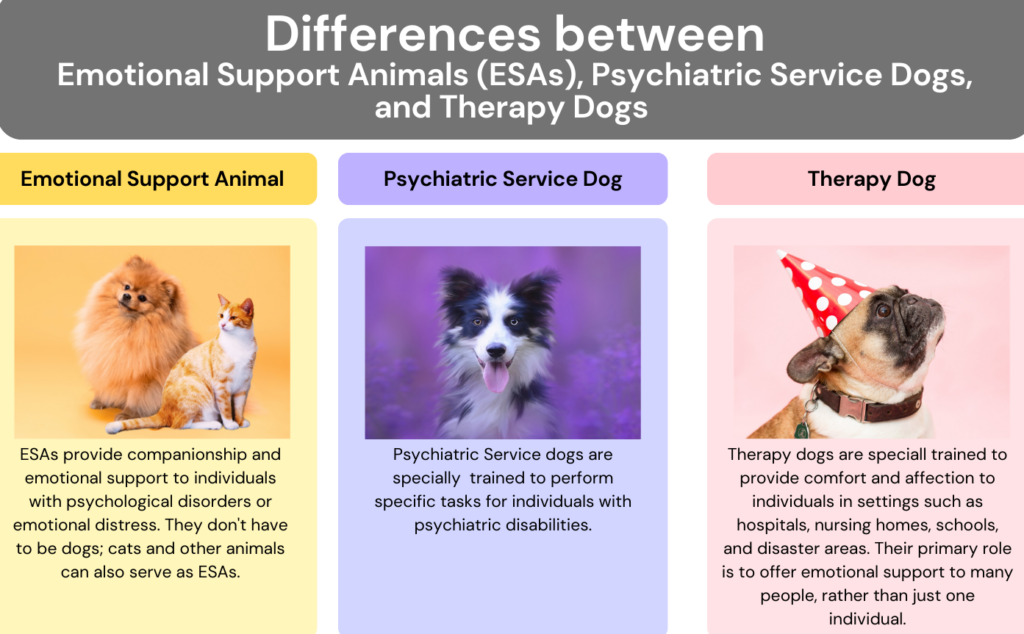
Therapy dogs, emotional support animals (ESAs), and psychiatric service dogs serve different roles and have different rights under the law. Here’s a breakdown of the differences:
Therapy Dogs:
- Purpose: These dogs are trained to provide comfort and affection to individuals in settings such as hospitals, nursing homes, schools, and disaster areas. Their primary role is to offer emotional support to many people, rather than just one individual.
- Training: While they do receive training to be well-behaved and calm in various situations, they aren’t specifically trained to perform tasks for a person with a disability.
- Rights: They don’t have the same legal rights as ESAs or service dogs. This means they can’t automatically live in housing that has a “no pets” policy, nor can they accompany their handlers in places where pets aren’t allowed.
- I specifically help people with their ESA and PSA needs. If you wish to make an appointment, you can do so here.
Emotional Support Animals (ESAs):
- Purpose: ESAs provide companionship and emotional support to individuals with psychological disorders or emotional distress. They don’t have to be dogs; cats and other animals can also serve as ESAs.
- Training: They aren’t required to undergo specific task-based training like service dogs. However, they should be well-behaved in public and not pose a threat to others.
- Rights: Under the Fair Housing Act, ESAs are allowed in housing units with “no pets” policies, and landlords cannot charge a pet fee for them. Previously, they had rights under the Air Carrier Access Act for air travel, but the rules have changed and they’re now considered pets for the purposes of air travel. If you need to make your animal an emotional support animal, go here to learn about the process and book an appointment so can assist you.
Psychiatric Service Dogs:
- Purpose: Psychiatric Service dogs (PSA) are trained to perform specific tasks for individuals with disabilities. A few examples of psychiatric service dog tasks might include medication reminding, alerting you when you are distressed, performing safety checks to alleviate fears for those with PTSD, or intervening during a person’s self-destructive behavior.
- Training: They undergo extensive training to perform specific tasks that mitigate the disability of their handler. This can take months to years of specialized training.
- Rights: Under the Americans with Disabilities Act (ADA), psychiatric service dogs are allowed to accompany their handlers in any public space, including businesses, public transportation, and other areas where the general public is allowed. They also have housing rights similar to ESAs. To learn more about the differences between an ESA and a PSA, go here.
It’s important to note that, in the context of the Americans with Disabilities Act (ADA), only dogs (and in some cases, miniature horses) can be classified as service animals. The distinction between these roles is important because each type of animal has different rights and protections under the law.

Emotional Support Animals of Texas https://emotionalsupportanimalsoftexas.com/
For more information: What is an ESA or PSA? How can I get a Texas ESA letter? Affordable ESA Letter ($78 session) About Dr. Tesh Psychiatric Service Dog Difference between ESA and PSA ESA at a University What to do if you are denied Affordable vet care in Texas Locations Reviews FAQ Texas ESA PSA Blog MAKE AN APPOINTMENT

